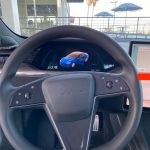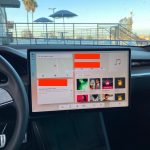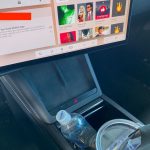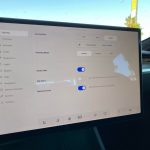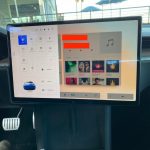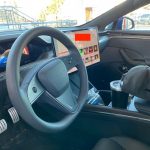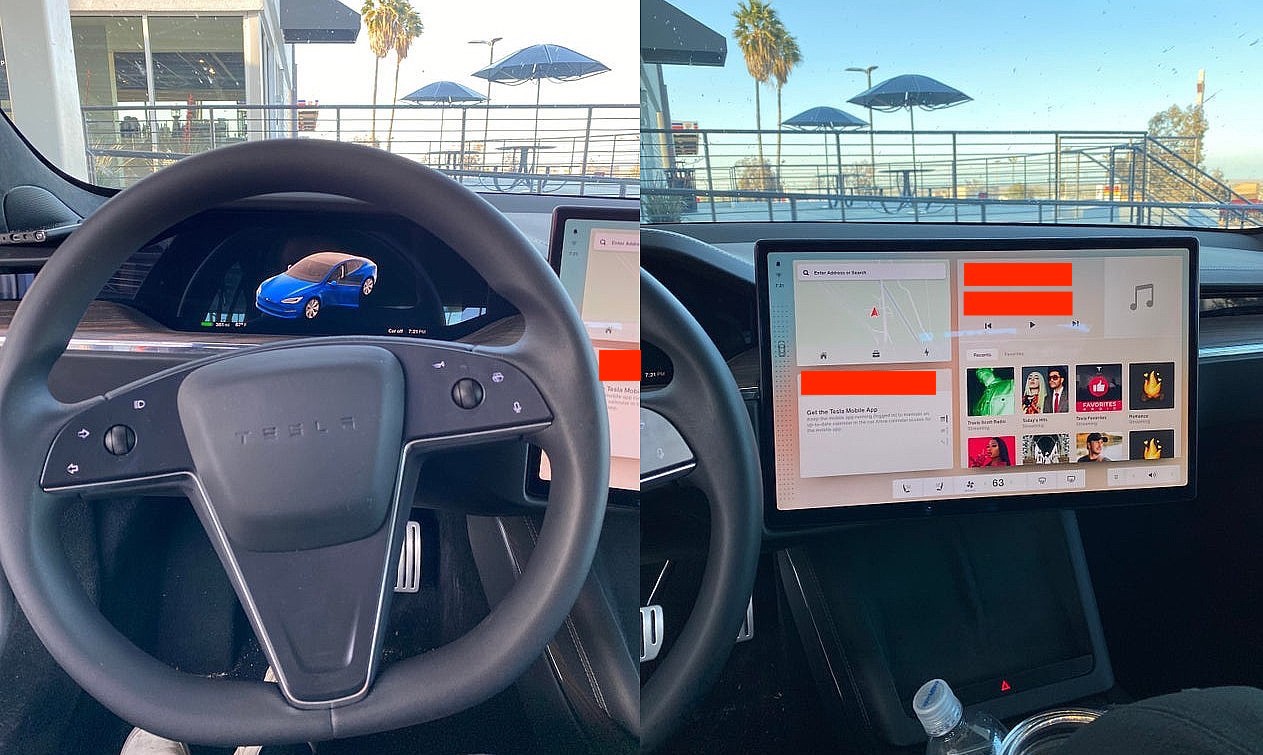
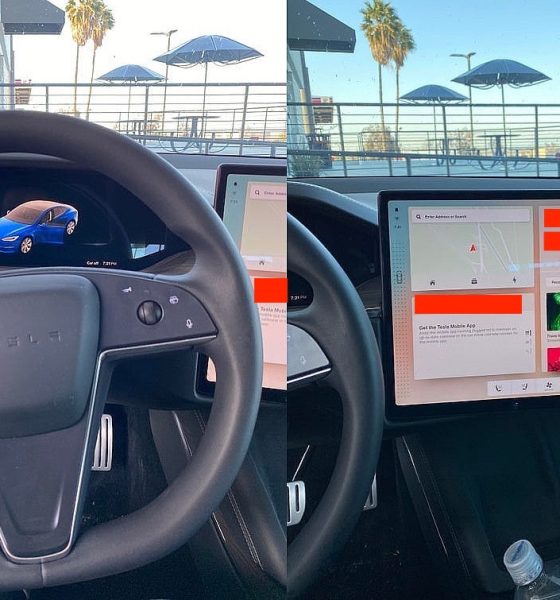
News
Tesla Model S refresh inside look reveals V11 UI, “Drag Strip Mode,” “Smart Shift,” and more
A recent sighting of a Tesla Model S refresh has provided what could very well be the first glimpse of software Version 11’s potential user interface, as well as some of its features. The images also showed how Tesla might utilize the Model S refresh’s Cybertruck-sized 17″ infotainment system and its instrument cluster.
In a post in the r/TeslaMotors subreddit, electric vehicle enthusiast u/FridayTheDog111 remarked that the images were taken in one of two high-mileage Model S refresh units that were traveling from Phoenix to Fremont. The EV enthusiast did not state where he encountered the vehicle, though the photos seemed to have been taken at the Kettleman Supercharger.
A look at the photos that the electric car enthusiast shared reveals that software V11 will feature some UI changes compared to V10. The vehicle’s 3D avatar, which seems to be about the same size as those in the Model 3 and Model Y, was displayed in the instrument cluster. This suggests that driving visualizations in the upcoming vehicle will be displayed in the instrument cluster, similar to its predecessor.
The additional screen real estate provided by the 17″ infotainment system seems notable, as could be seen in the display’s support of multiple widgets. But inasmuch as these are interesting, what truly stuck out in the recent photos were some of the features listed in the “Driving” menu of the new Model S. In the images, one could see new features such as “Smart Shift,” a dedicated “Drag Strip Mode,” and an option for “Insane” acceleration.
While the nature of the new features is yet to be announced by Tesla, “Smart Shift” seems to relate to a function that Elon Musk referenced in Twitter recently. In a tweet, the Tesla CEO noted that the Model S refresh would be able to operate without a shifter. A later leaked email provided additional details on the feature, with Musk stating that the system would use Autopilot cameras to determine if a vehicle should be in Park, Neutral, Reverse, or Drive. These capabilities seem to fit the bill of a “Smart Shift” function.
“Insane” acceleration is a throwback to the days of the Model S P85D, a variant of the all-electric flagship sedan that could go from 0-60 mph in 3.2 seconds. Insane Mode is partially responsible for the trend of Tesla owners sharing reaction videos of passengers experiencing the Model S’ acceleration for the first time. “Drag Strip Mode,” considering its moniker, seems to refer to a function that would allow drivers to launch their Model S with the best performance possible.
That being said, the fact that no “Plaid” references were in the recently-photographed Model S refresh’s images suggests that the car is a Dual Motor Long Range AWD variant. It should also be pointed out that the recent images only displayed a few screens and features that were available in the Model S refresh’s V11 software. Other features, particularly those that would be unique to the Model S Plaid, would likely be even more exciting.
Watch the Tesla Model S refresh perform a three-point turn before accelerating in the video below.
NEW Model S take off video. (See previous post as well) from r/teslamotors
Don’t hesitate to contact us for news tips. Just send a message to tips@teslarati.com to give us a heads up.

Elon Musk
Elon Musk and Tesla AI Director share insights after empty driver seat Robotaxi rides
The executives’ unoccupied tests hint at the rapid progress of Tesla’s unsupervised Robotaxi efforts.

Tesla CEO Elon Musk and AI Director Ashok Elluswamy celebrated Christmas Eve by sharing personal experiences with Robotaxi vehicles that had no safety monitor or occupant in the driver’s seat. Musk described the system’s “perfect driving” around Austin, while Elluswamy posted video from the back seat, calling it “an amazing experience.”
The executives’ unoccupied tests hint at the rapid progress of Tesla’s unsupervised Robotaxi efforts.
Elon and Ashok’s firsthand Robotaxi insights
Prior to Musk and the Tesla AI Director’s posts, sightings of unmanned Teslas navigating public roads were widely shared on social media. One such vehicle was spotted in Austin, Texas, which Elon Musk acknowleged by stating that “Testing is underway with no occupants in the car.”
Based on his Christmas Eve post, Musk seemed to have tested an unmanned Tesla himself. “A Tesla with no safety monitor in the car and me sitting in the passenger seat took me all around Austin on Sunday with perfect driving,” Musk wrote in his post.
Elluswamy responded with a 2-minute video showing himself in the rear of an unmanned Tesla. The video featured the vehicle’s empty front seats, as well as its smooth handling through real-world traffic. He captioned his video with the words, “It’s an amazing experience!”
Towards Unsupervised operations
During an xAI Hackathon earlier this month, Elon Musk mentioned that Tesla owed be removing Safety Monitors from its Robotaxis in Austin in just three weeks. “Unsupervised is pretty much solved at this point. So there will be Tesla Robotaxis operating in Austin with no one in them. Not even anyone in the passenger seat in about three weeks,” he said. Musk echoed similar estimates at the 2025 Annual Shareholder Meeting and the Q3 2025 earnings call.
Considering the insights that were posted Musk and Elluswamy, it does appear that Tesla is working hard towards operating its Robotaxis with no safety monitors. This is quite impressive considering that the service was launched just earlier this year.
Elon Musk
Starlink passes 9 million active customers just weeks after hitting 8 million
The milestone highlights the accelerating growth of Starlink, which has now been adding over 20,000 new users per day.

SpaceX’s Starlink satellite internet service has continued its rapid global expansion, surpassing 9 million active customers just weeks after crossing the 8 million mark.
The milestone highlights the accelerating growth of Starlink, which has now been adding over 20,000 new users per day.
9 million customers
In a post on X, SpaceX stated that Starlink now serves over 9 million active users across 155 countries, territories, and markets. The company reached 8 million customers in early November, meaning it added roughly 1 million subscribers in under seven weeks, or about 21,275 new users on average per day.
“Starlink is connecting more than 9M active customers with high-speed internet across 155 countries, territories, and many other markets,” Starlink wrote in a post on its official X account. SpaceX President Gwynne Shotwell also celebrated the milestone on X. “A huge thank you to all of our customers and congrats to the Starlink team for such an incredible product,” she wrote.
That growth rate reflects both rising demand for broadband in underserved regions and Starlink’s expanding satellite constellation, which now includes more than 9,000 low-Earth-orbit satellites designed to deliver high-speed, low-latency internet worldwide.
Starlink’s momentum
Starlink’s momentum has been building up. SpaceX reported 4.6 million Starlink customers in December 2024, followed by 7 million by August 2025, and 8 million customers in November. Independent data also suggests Starlink usage is rising sharply, with Cloudflare reporting that global web traffic from Starlink users more than doubled in 2025, as noted in an Insider report.
Starlink’s momentum is increasingly tied to SpaceX’s broader financial outlook. Elon Musk has said the satellite network is “by far” the company’s largest revenue driver, and reports suggest SpaceX may be positioning itself for an initial public offering as soon as next year, with valuations estimated as high as $1.5 trillion. Musk has also suggested in the past that Starlink could have its own IPO in the future.
News
NVIDIA Director of Robotics: Tesla FSD v14 is the first AI to pass the “Physical Turing Test”
After testing FSD v14, Fan stated that his experience with FSD felt magical at first, but it soon started to feel like a routine.

NVIDIA Director of Robotics Jim Fan has praised Tesla’s Full Self-Driving (Supervised) v14 as the first AI to pass what he described as a “Physical Turing Test.”
After testing FSD v14, Fan stated that his experience with FSD felt magical at first, but it soon started to feel like a routine. And just like smartphones today, removing it now would “actively hurt.”
Jim Fan’s hands-on FSD v14 impressions
Fan, a leading researcher in embodied AI who is currently solving Physical AI at NVIDIA and spearheading the company’s Project GR00T initiative, noted that he actually was late to the Tesla game. He was, however, one of the first to try out FSD v14.
“I was very late to own a Tesla but among the earliest to try out FSD v14. It’s perhaps the first time I experience an AI that passes the Physical Turing Test: after a long day at work, you press a button, lay back, and couldn’t tell if a neural net or a human drove you home,” Fan wrote in a post on X.
Fan added: “Despite knowing exactly how robot learning works, I still find it magical watching the steering wheel turn by itself. First it feels surreal, next it becomes routine. Then, like the smartphone, taking it away actively hurts. This is how humanity gets rewired and glued to god-like technologies.”
The Physical Turing Test
The original Turing Test was conceived by Alan Turing in 1950, and it was aimed at determining if a machine could exhibit behavior that is equivalent to or indistinguishable from a human. By focusing on text-based conversations, the original Turing Test set a high bar for natural language processing and machine learning.
This test has been passed by today’s large language models. However, the capability to converse in a humanlike manner is a completely different challenge from performing real-world problem-solving or physical interactions. Thus, Fan introduced the Physical Turing Test, which challenges AI systems to demonstrate intelligence through physical actions.
Based on Fan’s comments, Tesla has demonstrated these intelligent physical actions with FSD v14. Elon Musk agreed with the NVIDIA executive, stating in a post on X that with FSD v14, “you can sense the sentience maturing.” Musk also praised Tesla AI, calling it the best “real-world AI” today.
